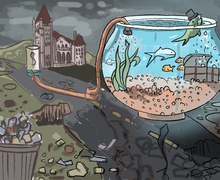Original run of ‘Will & Grace’ was revolutionary but problematic; reboot needs to portray queer characters fairly and realistically
NBC recently announced it would revive “Will & Grace” — the sitcom that former Vice President and Syracuse University alumnus Joe Biden once said “did more to educate the American public” on the LGBTQ community “than almost anything anybody’s ever done so far.”
Biden’s 2012 glowing review 0f “Will & Grace” came six years after the show went off the air, revealing its special position in American culture. When it debuted in 1998, the show made history for featuring two openly gay main characters. While LGBTQ characters had been on television before, “Will & Grace” was the first hit primetime program to feature them.
During the 2017-18 television season, modern audiences will be reacquainted with its queer characters. But can the “Will & Grace” reboot have the same social and cultural impact Biden described nearly five years ago? Although it was revolutionary for its time, it’s hard to find anything radical about “Will & Grace” today. The sitcom’s reboot needs to embrace diversity — both in its characterizations of queer people as well as the storylines they participate in.
Even though it was meant to represent queer communities, “Will & Grace” was produced for straight consumption. Perhaps as a result, the show indulged in every “gay character” trope in the book. And then, as if to add insult to injury, “Will & Grace” was unkind and often downright homophobic to its gay characters. Much of the show’s humor revolved around mocking feminine or stereotypically gay aspects of their personalities.
“I think there is a tension there because it was beloved,” said Robert Thompson, director of the Bleier Center for Television and Popular Culture at Syracuse University. “But at the same time… (it was) a walking thesaurus of stereotypes.”
While gay characters shouldn’t exist only to extinguish stereotypes, “Will & Grace” didn’t allow its protagonists much personality outside of their queer archetypes. The show sanitized gay life and gay culture to be as inoffensive as possible, as Will, Jack and their friends are all sexless, white and upper-middle class.
The sitcom scrubbed away anything that could possibly be alienating about queer communities in order to appeal to a mainstream audience. Storylines revolved around catty conflict, not fighting for civil rights. There may have been dating drama, but there was hardly ever any onscreen intimacy. The characters of “Will & Grace” are gay, but only in principle, not in practice.
Despite its shortcomings, the show’s importance is undeniable. Before “Will & Grace,” gay characters on television were relegated to the side, often as an easy joke. By simply focusing on the lives of its gay characters — caricatured or not — the show humanized queer communities to mainstream audiences.
Even if it wasn’t perfect, the stereotypical humor of “Will & Grace” was a game-changer for gay characters on television. For the first time, Americans were laughing with them — not at them.
“When it came on, it was really breaking some ground,” Thompson said. “And because it broke it so well, we’ve had all these other things that have come afterwards.”
Now, nearly 11 years after the sitcom’s finale aired, television’s portrayal of queer characters is a far cry from the days of “Will & Grace.” “Modern Family,” “How to Get Away with Murder” and “Empire” are among many primetime network television shows to feature queer main characters.
In fact, the Gay & Lesbian Alliance Against Defamation’s annual Where Are We On TV report showed that LGBTQ-identifying characters accounted for 4.8 percent of all series regulars in 2016 — the highest percentage of LGBTQ series regulars the group has ever found. And, unlike in “Will & Grace,” many of these characters go beyond archetypes that presume how queer people should look and behave.
This is not to say today’s media portrayal of LGBTQ people is not without its issues. Even in a new media landscape rich with queer characters, old conventions remain. The same GLAAD poll showed that queer characters on TV remain overwhelmingly white. It also revealed that, while the number of gay men was at its highest, queer women and trans people continue to be underrepresented.
There’s still much to improve about gay representation on television. So, even though “Will & Grace” was groundbreaking for its time, rebooting it today begs the question of why we are going back in time instead of progressing forward.
Queer representation in media has always been important, but it’s particularly urgent today. A man whose administration is circulating a proposed executive order that would legalize discrimination against LGBTQ people sits in the Oval Office. He, along with a Republican-majority Congress, have made it clear that endangering queer Americans is on the agenda.
“I think that show is going to have to go into territory that it originally didn’t [have to] in order to not seem outdated,” Thompson said. “There is an opportunity for the show to evolve by placing them in this current political climate and exploring that.”
Perhaps Biden was right to say that “Will & Grace” educated the American public. Now it’s ready for a more advanced course.
Gene Wang is a junior public relations major and women’s and gender studies minor. His column appears weekly. He can be reached at gwang19@syr.edu.
Published on February 22, 2017 at 10:19 pm





